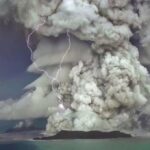There are concerns that the plume of dust from the volcano could carry on for some time. The last time that Eyjafjallajokull erupted in 1821 it is thought to have continued for two years.
An even bigger worry is that on each of the three occasions in Iceland’s history that the volcano has erupted, dating back to 920AD, it has led to an even more violent volcano, Katla, erupting soon afterwards.
The records show that Katla can shoot up enormous plumes of ash, gas and acid high into the atmosphere, blocking out the Sun’s energy and cooling the climate.
The effects on the UK could be severe. In June 1783 another nearby volcano called Laki erupted for several months, emitting clouds of poisonous gas that killed about 9,000 people in Iceland. The same eruption also created a cold fog that fanned out across much of Europe and North America, in some places causing the coldest summer for 500 years.
“The summer of the year 1783 was an amazing and portentous one, and full of horrible phenomena,” wrote the naturalist Gilbert White, in Hampshire. “The country people look with a kind of superstitious awe at the red louring aspect of the sun thro’ the fog.” The climate across the northern hemisphere was sent into upheaval, even weakening the monsoon rains in Africa and India, leading to chronic famine in Egypt and India.
Lees hele artikel ->timesonline.co.uk






De zomer van 1783 was niet koud in Nederland, en week nauwelijks af van voorgaande en later volgende zomers. Er werd in juli 1783 zelfs een temperatuur gemeten van 20,4, de hoogste juli-temperatuur in de periode 1773-1793. Zoek maar op in de data van Labrijn: http://www.knmi.nl/klimatologie/daggegevens/antie…
Nog even wachten op het verschijnen van deel zes van Jan Buisman's "Duizend jaar weer, wind en water in de Lage Landen". Daarin beschrijft Jan de periode 1750-1825 en misschien geeft Jan Buisman wat meer achtergrondinformatie.
Eh, die temperatuur van 20,4 (moet zijn 20,6) is niet gemeten, toch?
Het is een maandgemiddelde.
Zou er niet naar effecten in opvolgende maanden gekeken moeten worden?
Het septembergemiddelde duikt (bijvoorbeeld) van 1785 naar 1786 met 3,4 naar beneden.
Tja, het kan. Behalve IJsland kan ook Yellowstone morgen ontploffen. Het kan. Het kan ook nog 10 jaar duren. Of 100, 1000, 100000 …
Het huidige gepuf stelt in ieder geval niets voor, en heeft weinig of geen invloed op het klimaat.